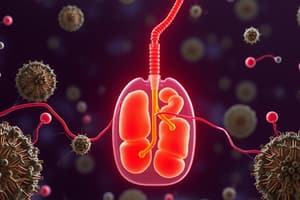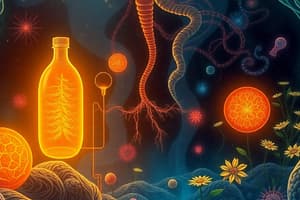Podcast
Questions and Answers
What is fermentation?
What is fermentation?
A process that produces ATP without the use of oxygen.
Where does fermentation take place?
Where does fermentation take place?
In the cytoplasm, and begins with glycolysis.
Why would a cell need fermentation?
Why would a cell need fermentation?
Some simple organisms like bacteria and yeast cannot carry on aerobic respiration because they lack the enzymes and/or mitochondria for the aerobic part of the reactions.
What is glycolysis?
What is glycolysis?
What does fermentation begin with?
What does fermentation begin with?
In the absence of oxygen, fermentation releases energy from
In the absence of oxygen, fermentation releases energy from
Muscle cells in animals can survive for a limited time in the anaerobic phase of cellular respiration, but
Muscle cells in animals can survive for a limited time in the anaerobic phase of cellular respiration, but
Anaerobic respiration breaks down glucose to either
Anaerobic respiration breaks down glucose to either
What is anaerobic respiration?
What is anaerobic respiration?
What are the two types of fermentation?
What are the two types of fermentation?
The end product depends on the type of
The end product depends on the type of
What is produced in lactic acid fermentation?
What is produced in lactic acid fermentation?
As a result of lactic acid fermentation:
As a result of lactic acid fermentation:
The 2 pyruvic acids (3 carbon each) are changed to 2 lactic acids (3 carbons each) with a total net gain of
The 2 pyruvic acids (3 carbon each) are changed to 2 lactic acids (3 carbons each) with a total net gain of
Alcoholic Fermentation: Yeast
Alcoholic Fermentation: Yeast
How does yeast produce alcohol and carbon dioxide?
How does yeast produce alcohol and carbon dioxide?
What causes bread to rise?
What causes bread to rise?
In anaerobic respiration, how many ATP are produced from each molecule of glucose?
In anaerobic respiration, how many ATP are produced from each molecule of glucose?
Lactic acid and alcohol still contain most of the chemical bond energy of the
Lactic acid and alcohol still contain most of the chemical bond energy of the
What are the end products?
What are the end products?
Flashcards are hidden until you start studying
Study Notes
Overview of Fermentation
- Fermentation is a process that generates ATP anaerobically, without oxygen.
- It occurs in the cytoplasm and starts with glycolysis, the breakdown of glucose into two pyruvic acid molecules.
Function and Importance
- Essential for organisms like bacteria and yeast that lack the necessary enzymes and mitochondria for aerobic respiration.
- Provides an alternative means for cells to produce ATP when oxygen is unavailable, known as anaerobic respiration.
Glycolysis and Pyruvic Acid
- Glycolysis converts glucose into two pyruvic acid molecules, setting the stage for fermentation.
- Fermentation utilizes these pyruvic acids to generate ATP without oxygen.
Energy Release During Fermentation
- In the absence of oxygen, energy is released from food molecules, mainly glucose.
- Muscle cells can temporarily rely on anaerobic respiration but must eventually obtain oxygen to continue aerobic processes.
Types of Anaerobic Byproducts
- Anaerobic respiration can result in two main products: lactic acid or alcohol and carbon dioxide.
- This variability depends on the organism undergoing fermentation.
Types of Fermentation
- Lactic Acid Fermentation:
- Converts glucose into 2 lactic acids and generates 2 ATP.
- Occurs in animal muscle cells, especially during fatigue, and in some bacteria.
- Important for dairy product production (milk, cheese, yogurt).
- Alcoholic Fermentation:
- Conversion of glucose to 2 ethyl alcohol, 2 CO2, and 2 ATP by yeast.
- Crucial for alcoholic beverages and baking processes.
ATP Production and Efficiency
- Only 2 ATP are produced per glucose molecule during anaerobic respiration.
- Lactic acid and alcohol produced still retain most of the energy from the original glucose.
Bread and Fermentation
- Carbon dioxide produced during alcoholic fermentation is responsible for causing bread to rise.
Conclusion
- The end products of fermentation still hold significant chemical energy, yet cells can function adequately with the ATP produced, satisfying their energy needs.
Studying That Suits You
Use AI to generate personalized quizzes and flashcards to suit your learning preferences.




